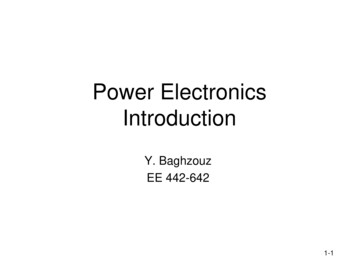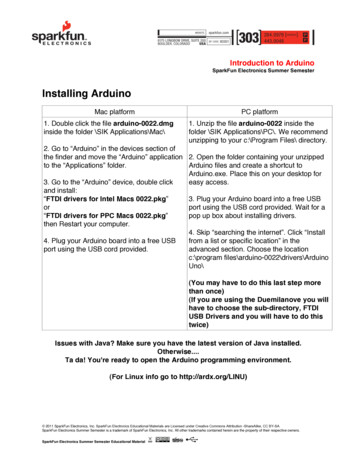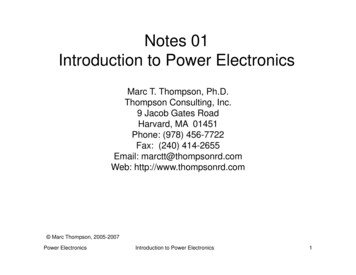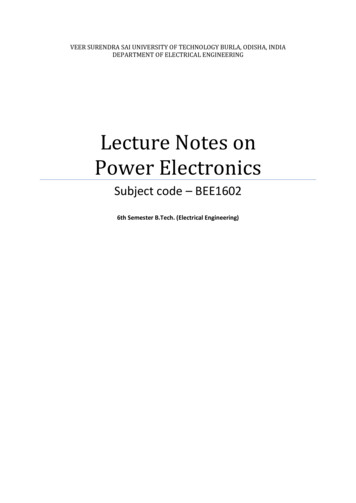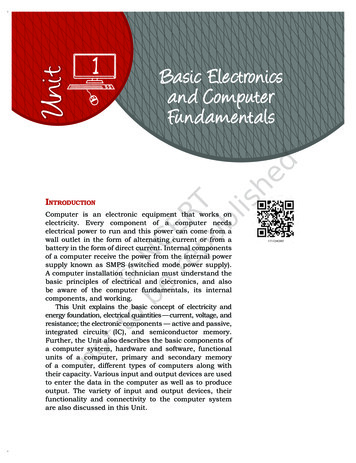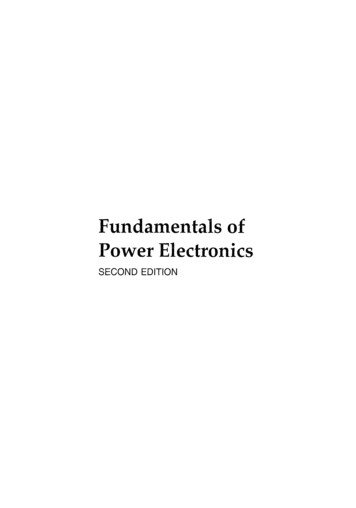
Transcription
Fundamentals ofPower ElectronicsSECOND EDITION
Fundamentals ofPower ElectronicsSECOND EDITIONRobert W. EricksonDragan MaksimovicUniversity of ColoradoBoulder, Colorado
Distributors for North, Central and South America:Kluwer Academic Publishers10 I Philip DriveAssinippi ParkNorwell, Massachusetts 02061 USATelephone (781) 871-6600Fax (781) 871-6528E-Mail kluwer@wkap.com Distributors for all other countries:Kluwer Academic Publishers GroupDistribution CentrePost Office Box 3223300 AH Dordrecht, THE NETHERLANDSTelephone 31 78 6576 000Fax 31 78 6576 254E-Mail services@wkap.nl .' ' Electromc Servtces http://www.wkap.nl Library of Congress Cataloging-in-PublicationErickson, Robert W. (Robert Warren), 1956Fundarnentals of power electronics I Robert W. Erickson, Dragan Maksimovic.--znd ed.p. em.Includes bibliographical references and index.ISBN 978-1-4757-0559-1ISBN 978-0-306-48048-5 (eBook)DOI 10.1007/978-0-306-48048-5I. Power electronics. I. Maksimovic, Dragan, 1961- II. Title.TK7881.15 .E75 2000621.381--dc2100-052569Copyright 2001 by Kluwer Academic Publishers. Sixth Printing 2004.Cover art Copyright 1999 by Lucent Technologies Inc. All rights reserved. Used withpermission.Softcover reprint of the hardcover 2nd edition 2001 978-0-7923-7270-7All rights reserved. No part of this publication may be reproduced, stored in a retrieval system ortransmitted in any form or by any means, mechanical, photo-copying, recording, or otherwise,without the prior written permission of the publisher, Kluwer Academic Publishers, 101 PhilipDrive, Assinippi Park, Norwell, Massachusetts 02061Printed on acid-free paper.
Dedicated toLinda, William, and RichardLidija, Filip, Nikola, and Stevan
ContentsxixPreface1Introduction1.1Introduction to Power Processing1.2Several Applications of Power ElectronicsElements of Power Electronics1.3179ReferencesIConverters in Equilibrium112Principles of Steady State Converter Analysis132.1Introduction132.2Inductor Volt-Second Balance, Capacitor Charge Balance, and the Small-RippleApproximationBoost Converter ExampleCuk Converter Example15222.32.42.5Estimating the Output Voltage Ripple in Converters Containing Two-PoleLow-Pass Filters2.6Summary of Key Points31Problems343435Steady-State Equivalent Circuit Modeling, Losses, and Efficiency39References3273.1The DC Transformer Model393.2Inclusion of Inductor Copper Loss423.3Construction of Equivalent Circuit Model45
viiiContents3.3.13.3.23.3.33.3.443.4How to Obtain the Input Port of the Model3.5Example: Inclusion of Semiconductor Conduction Losses in the BoostConverter Model646464748505256Summary of Key Points3.6References56Problems57Switch Realization634.1Switch .25Inductor Voltage EquationCapacitor Current EquationComplete Circuit ModelEfficiencySingle-Quadrant SwitchesCurrent-Bidirectional Two-Quadrant SwitchesVoltage-Bidirectional Two-Quadrant SwitchesFour-Quadrant SwitchesSynchronous RectifiersA Brief Survey of Power Semiconductor Devices744.2.14.2.24.2.34.2.44.2.57578818688Power DiodesMetal-Oxide-Semiconductor Field-Effect Transistor (MOSFET)Bipolar Junction Transistor (BJT)Insulated Gate Bipolar Transistor (IGBT)Thyristors (SCR, GTO, MCT)4.3Switching LossTransistor Switching with Clamped Inductive Load4.3.14.3.2Diode Recovered Charge4.3.3Device Capacitances, and Leakage, Package, and Stray InductancesEfficiency vs. Switching Frequency4.3.44.4Summary of Key PointsReferencesProblems92939698100101102103The Discontinuous Conduction Mode1075.1Origin of the Discontinuous Conduction Mode, and Mode Boundary1085.2Analysis of the Conversion Ratio M(D,K)1125.3Boost Converter Example1175.4Summary of Results and Key Points124Problems126Converter Circuits1316.1Circuit ManipulationsInversion of Source and Load6.1.1Cascade Connection of Converters6.1.26.1.3Rotation of Three-Terminal Cell132132134137
Contents6.1.4ixDifferential Connection of the LoadA Short List of ConvertersTransformer Isolation6.3.1 Full-Bridge and Half-Bridge Isolated Buck Converters6.3.2 Forward Converter6.3.3 Push-Pull Isolated Buck Converter6.3.4 Fly back Converter6.3.5 Boost-Derived Isolated Converters6.3.6 Isolated Versions of the SEPIC and the Cuk Converter6.4 Converter Evaluation and Design6.4.1 Switch Stress and Utilization6.4'.2 Design Using Computer Spreadsheet6.5 . Summary of Key 8171171174177177179IIConverter Dynamics and Control1857AC Equivalent Circuit 37.47.5IntroductionThe Basic AC Modeling ApproachAveraging the Inductor Waveforms7.2.17.2.2 Discussion of the Averaging Approximation7.2.3 Averaging the Capacitor Waveforms7.2.4 The Average Input Current7.2.5 Perturbation and Linearization7.2.6 Construction of the Small-Signal Equivalent Circuit Model7.2.7 Discussion of the Perturbation and Linearization Step7.2.8 Results for Several Basic Converters7.2.9 Example: A Nonideai Flyback ConverterState-Space Averaging7.3.1 The State Equations of a Network7.3.2 The Basic State-Space Averaged Model7.3.3 Discussion of the State-Space Averaging Result7.3.4 Example: State-Space Averaging of a Nonideal Buck-Boost ConverterCircuit Averaging and Averaged Switch Modeling7.4.1 Obtaining a Time-Invariant Circuit7.4.2 Circuit Averaging7.4.3 Perturbation and Linearization7.4.4 Switch Networks7.4.5 Example: Averaged Switch Modeling of Conduction Losses7.4.6 Example: Averaged Switch Modeling of Switching LossesThe Canonical Circuit Model7.5.1 Development of the Canonical Circuit Model
xContents7.5.27.5.38Example: Manipulation of the Buck-Boost Converter Modelinto Canonical FormCanonical Circuit Parameter Values for Some Common Converters7.6Modeling the Pulse-Width Modulator2537.7Summary of Key Points256References257Problems258Converter Transfer Functions2658.1Review of Bode 92752762772782822872898.2Single Pole ResponseSingle Zero ResponseRight Half-Plane ZeroFrequency InversionCombinationsQuadratic Pole Response: ResonanceThe Low-Q ApproximationApproximate Roots of an Arbitrary-Degree PolynomialAnalysis of Converter Transfer Functions8.2.18.2.28.2.3Example: Transfer Functions of the Buck-Boost ConverterTransfer Functions of Some Basic CCM ConvertersPhysical Origins of the RHP Zero in Converters2932943003008.3Graphical Construction of Impedances and Transfer Functions3023033053083093118.48.3.1Series Impedances: Addition of AsymptotesSeries Resonant Circuit Example8.3.28.3.3Parallel Impedances: Inverse Addition of AsymptotesParallel Resonant Circuit Example8.3.48.3.5Voltage Divider Transfer Functions: Division of AsymptotesGraphical Construction of Converter Transfer FunctionsMeasurement of AC Transfer Functions and Impedances8.5Summary of Key ontroller Design3319.1Introduction3319.2Effect of Negative Feedback on the Network Transfer Functions3349.2.19.2.2Feedback Reduces the Transfer Functionsfrom Disturbances to the OutputFeedback Causes the Transfer Function from the Reference Inputto the Output to be Insensitive to Variations in the Gains in theForward Path of the Loop9.3Construction of the Important Quantities 11( 1 T) and Tl( 1 T)and the Closed-Loop Transfer Functions9.4Stability335337337340
Contents9.4.19.4.29.4.39.59.69.710The Phase Margin TestThe Relationship Between Phase Marginand Closed-Loop Damping FactorTransient Response vs. Damping Factor341342346Regulator Design3479.5.19.5.29.5.39.5.4348351353354Lead (PD) CompensatorLag (PI) CompensatorCombined (P/D) CompensatorDesign ExampleMeasurement of Loop Gains3629.6.19.6.29.6.3364367368Voltage InjectionCurrent InjectionMeasurement of Unstable SystemsSummary of Key Points369References369Problems369Input Filter ed EMIThe Input Filter Design Problem37910.2Effect of an Input Filter on Converter Transfer Functions38110.310.2.1 Discussion10.2.2 Impedance InequalitiesBuck Converter Example38238438510.3.1 Effect of Undamped Input Filter10.3.2 Damping the Input Filter10.4 Design of a Damped Input Filter10.4.1 RrCb Parallel Damping10.4.2 RrLb Parallel Damping10.4.3 RrLb Series Damping10.4.4 Cascading Filter Sections10.4.5 Example: Two Stage Input Filter10.5 Summary of Key Problems406AC and DC Equivalent Circuit Modeling of the Discontinuous Conduction Mode40911.1DCM Averaged Switch Model11.2Small-Signal AC Modeling of the DCM Switch Network11.2.1 Example: Control-to-Output Frequency Responseof a DCM Boost Converter11.2.2 Example: Control-to-Output Frequency Responsesof a CCM/DCM SEPIC410420428429
Contentsxii11.311.412High-Frequency Dynamics of Converters in DCMSummary of Key Points431ReferencesProblems434434435Current Programmed Control43912.1Oscillation forD 0.544112.2A Simple First-Order Model12.2.1 Simple Model via Algebraic Approach: Buck-Boost Example12.2.2 Averaged Switch Modeling12.3A More Accurate Model12.3.1 Current-Programmed Controller Model12.3.2 Solution of the CPM Transfer Functions12.3.3 Discussion12.3.4 Current-Programmed Transfer Functions of the CCM Buck Converter12.3.5 Results for Basic Converters12.3.6 Quantitative Effects of Current-Programmed Controlon the Converter Transfer Functions44945045445912.4Discontinuous Conduction Mode12.5 Summary of Key 1482III Magnetics48913Basic Magnetics 1251451551852052213.213.313.4Review of Basic Magnetics13.1.1 Basic Relationships13.1.2 Magnetic CircuitsTransformer Modeling13.2.1 The Ideal Transformer13.2.2 The Magnetizing Inductance13.2.3 Leakage InductancesLoss Mechanisms in Magnetic Devices13.3.1 Core Loss13.3.2 Low-Frequency Copper LossEddy Currents in Winding Conductors13.4.1 Introduction to the Skin and Proximity Effects13.4.2 Leakage Flux in Windings13.4.3 Foil Windings and Layers13.4.4 Power Loss in a Layer13.4.5 Example: Power Loss in a Transformer Winding13.4.6 Interleaving the Windings13.4.7 PWM Waveform Harmonics
ContentsxiiiSeveral Types of Magnetic Devices, Their B-H Loops,and Core vs. Copper Loss13.5.1 Filter Inductor13.5.2 AC Inductor13.5.3 Transformer13.5.4 Coupled Inductor13.5.5 Flyback Transformer13.6 Summary of Key 3Inductor Design53914.1Filter Inductor Design Constraints14.1.1 Maximum Flux Density14.1.2 Inductance14.1.3 Winding Area14.1.4 Winding Resistance14.1.5 The Core Geometrical Constant Kg53954154254254354314.214.3A Step-by-Step ProcedureMultiple-Winding Magnetics Design via the Kg Method54454514.3.1 Window Area Allocation14.3.2 Coupled Inductor Design Constraints14.3.3 Design Procedure14.4 Examples14.4.1 Coupled Inductor for a Two-Output Forward Converter14.4.2 CCM Fly back Transformer14.5 Summary of Key 3Transformer 8213.5141515.215.315.4Transformer Design: Basic Constraints15.1.1 Core Loss15.1.2 Flux Density15.1.3 Copper Loss15.1.4 Total Power Loss vs. till15.1.5 Optimum Flux DensityA Step-by-Step Transformer Design ProcedureExamples15.3.1 Example 1: Single-Output Isolated Cuk Converter15.3.2 Example 2: Multiple-Output Full-Bridge Buck ConverterAC Inductor Design15.4.1 Outline of Derivation15.4.2 Step-by-Step AC Inductor Design Procedure
xivContents15.5Summary583Problems584IV Modern Rectifiers and Power System Harmonics16Power and Harmonics in Nonsinusoidal Systems16.1Average Power16.2Root-Mean-Square (RMS) Value of a Waveform16.3Power Factor16.3.1 Linear Resistive Load, Nonsinusoidal Voltage16.3.2 Nonlinear Dynamic Load, Sinusoidal Voltage58959059359459459516.4Power Phasors in Sinusoidal Systems598Harmonic Currents in Three-Phase Systems59916.6Harmonic Currents in Three-Phase Four-Wire NetworksHarmonic Currents in Three-Phase Three-Wire NetworksHarmonic Current Flow in Power Factor Correction CapacitorsAC Line Current Harmonic onal Electrotechnical Commission Standard 1000IEEE/ANSI Standard 519Line-Commutated Rectifiers17.117.2The Single-Phase Full-Wave Rectifier17.1.1 Continuous Conduction Mode17.1.2 Discontinuous Conduction Mode17.1.3 Behavior when Cis Large17.1.4 Minimizing THD when C is SmallThe Three-Phase Bridge Rectifier17.2.1 Continuous Conduction Mode17.2.2 Discontinuous Conduction 1561661717.4Phase Control17.3.1 Inverter Mode17.3.2 Harmonics and Power Factor17.3.3 CommutationHarmonic Trap Filters62217.5Transformer dth Modulated .5.317583References18.1Properties of the Ideal Rectifier619619620638
Contents18.2Realization of a Near-Ideal Rectifierxv640CCM Boost ConverterDCM Flyback Converter64264618.3Control of the Current Waveform64818.418.3.1 Average Current Control18.3.2 Current Programmed Control18.3.3 Critical Conduction Mode and Hysteretic Control18.3.4 Nonlinear Carrier ControlSingle-Phase Converter Systems Incorporating Ideal Rectifiers64865465765966366366818.518.4.1 Energy Storage18.4.2 Modeling the Outer Low-Bandwidth Control SystemRMS Values of Rectifier Waveforms67467618.618.5.1 Boost Rectifier Example18.5.2 Comparison of Single-Phase Rectifier TopologiesModeling Losses and Efficiency in CCM High-Quality Rectifiers67968168368418.718.6.1 Expression for Controller Duty Cycle d(t)18.6.2 Expression for the DC Load Current18.6.3 Solution for Converter Efficiency 1118.6.4 Design ExampleIdeal Three-Phase Rectifiers18.8Summary of Key s696vResonant Converters70319Resonant Conversion70519.1Sinusoidal Analysis of Resonant Converters19.1.1 Controlled Switch Network Model19.1.2 Modeling the Rectifier and Capacitive Filter Networks19.1.3 Resonant Tank Network19.1.4 Solution of Converter Voltage Conversion Ratio M V!Vg70971071171371419.2Examples19.2.1 Series Resonant DC-DC Converter Example19.2.2 Subharmonic Modes of the Series Resonant Converter19.2.3 Parallel Resonant DC-DC Converter Example19.3Soft Switching71571571771872119.3.119.3.219.4Operation of the Full Bridge Below Resonance:Zero-Current SwitchingOperation of the Full Bridge Above Resonance:Zero-Voltage SwitchingLoad-Dependent Properties of Resonant Converters19.4.1 Inverter Output Characteristics19.4.2 Dependence of Transistor Current on Load19.4.3 Dependence of the ZVS/ZCS Boundary on Load Resistance722723726727729734
xviContents19.4.420Another Example19.5Exact Characteristics of the Series and Parallel Resonant Converters19.619.5.1 Series Resonant Converter19.5.2 Parallel Resonant ConverterSummary of Key Points737740740748References752752Problems755Soft Switching76120.1Soft-Switching Mechanisms of Semiconductor Devices76276376576820.220.1.1 Diode Switching20.1.2 MOSFET Switching20.1.3 IGBT SwitchingThe Zero-Current-Switching Quasi-Resonant Switch Cell20.2.120.2.220.2.3Waveforms of the Half-Wave ZCS Quasi-Resonant Switch CellThe Average Terminal WaveformsThe Full-Wave ZCS Quasi-Resonant Switch Cell76877077477920.3Resonant Switch Topologies78178378478720.420.3.1 The Zero-Voltage-Switching Quasi-Resonant Switch20.3.2 The Zero-Voltage-Switching Multi-Resonant Switch20.3.3 Quasi-Square-Wave Resonant SwitchesSoft Switching in PWM Converters20.4.1 The Zero-Voltage Transition Full-Bridge Converter20.4.2 The Auxiliary Switch Approach20.4.3 Auxiliary Resonant Commutated Pole20.5 Summary of Key PointsReferencesProblemsAppendicesAppendix A790791794796797798800803RMS Values of Commouly-Observed Converter Waveforms805A.lSome Common Waveforms805A.2General Piecewise Waveform809Appendix BB.lB.2Simulation of ConvertersAveraged Switch Models for Continuous Conduction ModeB.l.lBasic CCM Averaged Switch ModelB.l.2CCM Subcircuit Model that Includes Switch Conduction LossesB.l.3Example: SEPIC DC Conversion Ratio and EfficiencyB.l.4Example: Transient Response of a Buck-Boost ConverterCombined CCM/DCM Averaged Switch ModelB.2.lExample: SEPIC Frequency ResponsesB.2.2Example: Loop Gain and Closed-Loop Responsesof a Buck Voltage Regulator813815815816818819822825827
ContentsB.2.3 Example: DCM Boost RectifierCurrent Programmed ControlCurrent Programmed Mode Model for SimulationB.3.1B.3.2 Example: Frequency Responses of a Buck Converter withCurrent Programmed ControlReferencesB.3AppendixCMiddlebrook's Extra Element TheoremBasic ResultDerivationDiscussionExamplesA Simple Transfer FunctionC.4.1C.4.2 An Unmodeled ElementC.4.3 Addition of an Input Filter to a ConverterC.4.4 Dependence of Transistor Current on Load in a Resonant InverterReferencesC.lC.2C.3C.4AppendixDMagnetics Design TablesPot Core DataD.lD.2 EE Core DataD.3 EC Core DataD.4 . ETD Core DataD.5 PQ Core DataD.6 American Wire Gauge 850850855857859861863864865866866867868869871
PrefaceThe objective of the First Edition was to serve as a textbook for introductory power electronics courseswhere the fundamentals of power electronics are defined, rigorously presented, and treated in sufficientdepth so that students acquire the knowledge and skills needed to design practical power electronic systems. The First Edition has indeed been adopted for use in power electronics courses at a number ofschools. An additional goal was to contribute as a reference book for engineers who practice power electronics design, and for students who want to develop their knowledge of the area beyond the level ofintroductory courses. In the Second Edition, the basic objectives and philosophy of the First Edition havenot been changed. The modifications include addition of a number of new topics aimed at better servingthe expanded audience that includes students of introductory and more advanced courses, as well aspracticing engineers looking for a reference book and a source for further professional development.Most of the chapters have been significantly revised and updated. Major additions include a new Chapter10 on input filter design, a new Appendix B covering simulation of converters, and a new Appendix C onMiddlebrook's Extra Element Theorem. In addition to the introduction of new topics, we have mademajor revisions of the material to improve the flow and clarity of explanations and to provide additionalspecific results, in chapters covering averaged switch modeling, dynamics of converters operating in discontinuous conduction mode, current mode control, magnetics design, pulse-width modulated rectifiers,and resonant and soft-switching converters.A completely new Chapter 10 covering input filter design has been added to the second addition. The problem of how the input filter affects the dynamics of the converter, often in a manner thatdegrades stability and performance of the converter system, is explained using Middlebrook's Extra Element Theorem. This design-oriented approach is explained in detail in the new Appendix C. Simple conditions are derived to allow filter damping so that converter transfer functions are not changed. Completeresults for optimum filter damping are presented. The chapter concludes with a discussion about thedesign of multiple-section filters, illustrated by a design example.Computer simulation based on the averaged switch modeling approach is presented in Appendix B, including PSpice models for continuous and discontinuous conduction mode, and current-modecontrol. Extensive simulation examples include: finding the de conversion ratio and efficiency of aSEPIC, plotting the transient response of a buck-boost converter, comparing the control-to-output transfer functions of a SEPIC operating in CCM and DCM,determining the loop gain, line-to-output transferfunction, and load transient response of a closed-loop buck voltage regulator, finding the input current
xxPrefacewaveform and THD of a DCM boost rectifier, and comparing the transfer functions and output impedances of buck converters operating with current programmed control and with duty cycle control. Themajor purpose of Appendix B is to supplement the text discussions, and to enable the reader to effectively use averaged models and simulation tools in the design process. The role of simulation as a designverification tool is emphasized. In our experience of teaching introductory and more advanced powerelectronics courses, we have found that the use of simulation tools works best with students who havemastered basic concepts and design-oriented analytical techniques, so that they are able to make correctinterpretations of simulation results and model limitations. This is why we do not emphasize simulationin introductory chapters. Nevertheless, Appendix B is organized so that simulation examples can beintroduced together with coverage of the theoretical concepts of Chapters 3, 7, 9, 10, 11, 12, and 18.Middlebrook's Extra Element Theorem is presented in Appendix C, together with four tutorialexamples. This valuable design-oriented analytical tool allows one to examine effects of adding an extraelement to a linear system, without solving the modified system all over again. The theorem has manypractical applications in the design of electronic circuits, from solving circuits by inspection, to quicklyfinding effects of unmodeled parasitic elements. In particular, in the Second Edition, Middlebrook'sExtra Element Theorem is applied to the input filter design of Chapter 10, and to resonant inverter designin Chapter 19.In Chapter 7, we have revised the section on circuit averaging and averaged switch modeling.The process of circuit averaging and deriving averaged switch models has been explained to allow readers not only to use the basic models, but also to construct averaged models for other applications of interest. Examples of extensions of the averaged switch modeling approach include modeling of switchconduction and switching losses. Related to the revision of Chapter 7, in Appendix B we have includednew material on simulation of converters based on the averaged switch modeling approach.Chapter 8 contains a new substantial introduction that explains the engineering design processand the need for design-oriented analysis. The discussions of design-oriented methods for constructionof frequency response have been revised and expanded. A new example has been added, involvingapproximate analysis of a damped input filter.Chapter 11 on dynamics of DCM (discontinuous conduction mode) converters, and Chapter 12on current-mode control, have been thoroughly revised and updated. Chapter 11 includes a simplifiedderivation of DCM averaged switch models, as well as an updated discussion of high-frequency DCMdynamics. Chapter 12 includes a new, more straightforward explanation and discussion of current-modedynamics, as well as new complete results for transfer functions and model parameters of all basic converters.The chapters on magnetics design have been significantly revised and reorganized. Basic magnetics theory necessary for informed design of magnetic components in switching power converters ispresented in Chapter 13. The description of the proximity effect has been completely revised, to explainthis important but complex subject in a more intuitive manner. The design of magnetic components basedon the copper loss constraint is described in Chapter 14. A new step-by-step design procedure is givenfor multiple-winding inductors, and practical design examples are included for the design of filter inductors, coupled inductors and fly back transformers. The design of magnetic components (transformers andac inductors) based on copper and core loss considerations is described in Chapter 15.To improve their logical flow, the chapters covering pulse-width modulated rectifiers have beencombined into a single Chapter 18, and have been completely reorganized. New sections on current control based on the critical conduction mode, as well as on operation of the CCM boost and DCM fly backas PWM rectifiers, have been added.Part V consists of Chapter 19 on resonant converters and Chapter 20 on soft-switching converters. The discussion of resonant inverter design, a topic of importance in the field of high-frequency electronic ballasts, has been expanded and explained in a more intuitive manner. A new resonant inverter
xxidesign example has also been added to Chapter 19. Chapter 20 contains an expanded tutorial explanationof switching loss mechanisms, new charts illustrating the characteristics of quasi-square-wave and multiresonant converters, and new up-to-date sections about soft-switching converters, including the zerovoltage transition full-bridge converter, the auxiliary switch approach, and the auxiliary resonant commutated pole approach for de-de converters and dc-ac inverters.The material of the Second Edition is organized so that chapters or sections of the book can beselected to offer an introductory one-semester course, but yet enough material is provided for a sequenceof more advanced courses, or for individual professional development. At the University of Colorado, wecover the material from the Second Edition in a sequence of three semester-long power electronicscourses. The first course, intended for seniors and first-year graduate students, covers Chapters 1 to 6,Sections 7.1, 7.2, 7.5, and 7.6 from Chapter 7, Chapters 8 and 9, and Chapters 13 to 15. A project-oriented power electronics design laboratory is offered in parallel with this course. This course serves as aprerequisite for two follow-up courses. The second course starts with Section 7.4, proceeds to Appendices B and C, Chapters 10, 11 and 12, and concludes with the material of Chapters 16 to 18. In the thirdcourse we cover resonant and soft-switching techniques of Chapters 19 and 20.The website for the Second Edition contains comprehensive supporting materials for the text,including solved problems and slides for instructors. Computer simulation files can be downloaded fromthis site, including a PSpice library of averaged switch models, and simulation examples.This text has evolved from courses developed over seventeen years of teaching power electronics at the University of Colorado. These courses, in tum, were heavily influenced by our previous experiences as graduate students at the California Institute of Technology, under the direction of Profs.Slobodan Cuk and R. D. Middlebrook, to whom we are grateful. We appreciate the helpful suggestionsof Prof. Arthur Witulski of the University of Arizona. We would also like to thank the many readers ofthe First Edition, students, and instructors who offered their comments and suggestions, or who pointedout errata. We have attempted to incorporate these suggestions wherever possible.ROBERTW. ERICKSONDRAGAN MAKSIMOVICBoulder, Colorado
4.2 A Brief Survey of Power Semiconductor Devices 74 4.2.1 Power Diodes 75 4.2.2 Metal-Oxide-Semiconductor Field-Effect Transistor (MOSFET) 78 4.2.3 Bipolar Junction Transistor (BJT) 81 4.2.4 Insulated Gate Bipolar Transistor (IGBT) 86


